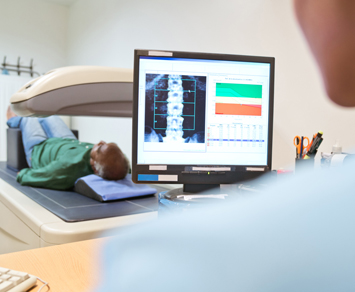Bone Densitometry
What is Bone Density (DEXA)?
Bone densitometry, also called DEXA (dual-energy X-ray absorptiometry), is a medical imaging exam that uses an enhanced form of X-ray to measure bone density and bone loss.
What should I bring to my appointment?
- Your insurance card and a valid photo ID.
- Please arrive 15 minutes early to complete registration.
How should I prepare for my exam?
Do not take vitamins, calcium supplements, or antacids the morning of your exam.
Wear comfortable clothes without metal fasteners, including zippers, buttons, and snaps.
Let us know about any of the following:
- Hip replacement or any type of lumbar spine surgery
- Any nuclear medicine contrast studies (within the past three weeks)
- Any barium studies (within the past week)
- Pregnancy - known or possible
- A current list of medications
- Any previous DEXA scans done at another facility so our radiologists can do a comparison
How long will my exam take?
Bone density exams typically take 15-20 minutes.
What happens during my exam?
You will be positioned on a cushioned table. A detector will slowly move above your body to capture the images. Images are taken of two different areas susceptible to fracture or other bone damage, usually the hip and spine. For the best quality images, you will be asked to remain as still as possible during the exam.
What happens after my exam?
Your images will be interpreted by one of our board-certified radiologists. The findings will be sent to your healthcare provider who will then contact you to discuss the results.
Your readings will be compared to reference readings taken from adults of your gender while at their peak bone mass. The result of this comparison is called a T-score, which tells you and your healthcare provider how your bone density results compare across a range. This score indicates the risk of fracture.
T-scores indicate the risk of fracture:
- 0 to -1 is normal
- -1 to -2.5 is osteopenia
- -2.5 indicates osteoporosis
When measured at a variety of body areas, low bone mass is the most accurate predictor of high fracture risk. When your healthcare provider has information from two areas of the body that are prone to fracture, the diagnosis can be more accurate and the treatment more specific. Your healthcare provider can offer advice about diet, lifestyle, and medication based on your T-score. Treatments are available to increase your bone density and slow the rate of loss.
It is recommended that you get a baseline T-score between the ages of 30 and 40.

 Copyright © 2025 · Minneapolis Radiology Associates ·
Copyright © 2025 · Minneapolis Radiology Associates ·